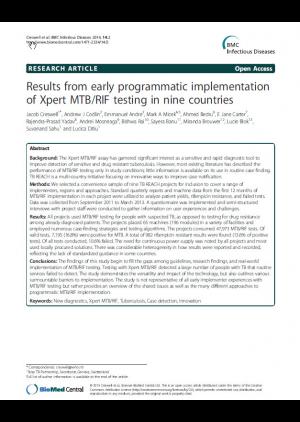Background: The Xpert MTB/RIF assay has garnered significant interest as a sensitive and rapid diagnostic tool to improve detection of sensitive and drug resistant tuberculosis. However, most existing literature has described the performance of MTB/RIF testing only in study conditions; little information is available on its use in routine case finding. TB REACH is a multi-country initiative focusing on innovative ways to improve case notification.
Methods: We selected a convenience sample of nine TB REACH projects for inclusion to cover a range of implementers, regions and approaches. Standard quarterly reports and machine data from the first 12 months of MTB/RIF implementation in each project were utilized to analyze patient yields, rifampicin resistance, and failed tests. Data was collected from September 2011 to March 2013. A questionnaire was implemented and semi-structured interviews with project staff were conducted to gather information on user experiences and challenges.
Results: All projects used MTB/RIF testing for people with suspected TB, as opposed to testing for drug resistance among already diagnosed patients. The projects placed 65 machines (196 modules) in a variety of facilities and employed numerous case-finding strategies and testing algorithms. The projects consumed 47,973 MTB/RIF tests. Of valid tests, 7,195 (16.8%) were positive for MTB. A total of 982 rifampicin resistant results were found (13.6% of positive tests). Of all tests conducted, 10.6% failed. The need for continuous power supply was noted by all projects and most used locally procured solutions. There was considerable heterogeneity in how results were reported and recorded, reflecting the lack of standardized guidance in some countries.
